 |
 |
 |
| |
400,000 IU/mL Is New Cut-Off for Low vs High Viral Load in HCV
|
| |
| |
Reported by Jules Levin
EASL, April 2007, Barcelona, Spain
"Optimal pre-treatment HCV RNA level for prediction of SVR
with peginterferon alfa-2a (40KD) (PEGASYS) plus ribavirin
(COPEGUS) in genotype 1 patients: Generalised Additive logistic
regression Model (GAM) analysis"
S. Zeuzem,1 M.W. Fried,2 F. Torriani,3 E. Zehnter,4 T. Berg,5 A. Lin,6 S.J. Hadziyannis7
1J.W. Goethe-University Hospital, Frankfurt, Germany; 2University of North Carolina, Chapel Hill, NC, USA; 3University of California, San Diego, CA, USA; 4Center of Gastroenterology Dortmund, Dortmund, Germany;
5Charité, Campus Virchow-Clinic, Humboldt University Berlin, Berlin, Germany; 6Roche, Nutley, NJ, USA; 7Henry Dunant Hospital, Athens, Greece
".... the cut-off of >400 000 IU/mL identified the greatest difference in SVR rates between patients with LVL and HVL... (70% vs 43%, vs 63% vs 43% for <600,000>, and...60% vs 43% for <800,000>)..."
By the way this information is not new. A similar analysis has been presented previously at a conference.
INTRODUCTION
Hepatitis C virus (HCV) genotype and pre-treatment viral load are the most important viral prognostic factors in patients treated for chronic hepatitis C.[1] Genotype 1 patients with 'high' and 'low' pre-treatment viral load (HVL, LVL) have different probabilities of sustained virological response (SVR). Therefore, identification of an appropriate HCV RNA value to define HVL is important in the development of optimal treatment strategies. Historically, HVL has been defined variously as an HCV RNA level >2 million copies/mL, which converts to >600 000
IU/mL or >800 000 IU/mL depending on the assay used. It is important to note that this definition for HVL originated in the era of conventional interferon-based therapy. As pegylated interferon has superseded conventional interferon as the standard of care for chronic hepatitis C due to superior efficacy,[1] there is now a need to re-evaluate the current definitions to better optimise treatment outcomes.
We employed a two-step approach to re-examine the correlation between HCV RNA level and the probability of SVR by analysing data from several clinical studies evaluating therapy with peginterferon alfa-2a (40KD) (PEGASYS) plus ribavirin (COPEGUS).
-- Initially we explored the most appropriate viral load cut-off to differentiate HVL versus LVL using data from two randomised, multinational, phase III trials (n=568) in which patients with HCV genotype 1 were treated with peginterferon alfa-2a (40KD) (PEGASYS) plus ribavirin (COPEGUS) for 48 weeks.[2,3]
-- Subsequently we validated this cut-off by examining data from five studies (n=1217), including those from the initial data mining phase.[2-6]
AUTHOR CONCLUSION
The current GAM analysis demonstrates that an HCV RNA level >400 000 IU/mL is the most clinically relevant definition for HVL.
This threshold, based on using the COBAS AMPLICOR HCV Test, best differentiates the probabilities of achieving an SVR with peginterferon alfa-2a (40KD) plus ribavirin. A 400 000 IU/mL HCV RNA cut-off resulted in the greatest difference in SVR rate between patients with a LVL and a HVL. While HVL remains a poor prognostic factor, it must be remembered that HCV genotype 1 patients with a LVL have a high chance of SVR, which increases as baseline HCV RNA decreases. Others have also demonstrated that a baseline HCV RNA cut-off of 400 000 IU/mL best discriminates between LVL and HVL in HCV genotype 1 patients based on the probability of achieving an SVR.[8,9] This validated cut-off can now be incorporated into the design of prospective studies that are examining alternative treatment strategies in this 'difficult-to-cure' population.
METHODS
Patients
--Patients eligible for the studies had chronic hepatitis C, quantifiable HCV RNA (>600 IU/mL) and elevated alanine aminotransferase (ALT) levels in serum, and had not received previous interferon-based treatment. Those included in this analysis were HCV genotype 1 patients who were randomised to 48 weeks of treatment with peginterferon alfa-2a (40KD) 180 _g/week plus ribavirin, 1000 or 1200 mg/day.
--All patients with a measurement of pre-treatment HCV RNA who received >/=1 dose of therapy were included.
Viral load measurements
--SVR was defined as undetectable HCV RNA (<50 IU/mL by qualitative PCR, COBAS AMPLICOR HCV Test, v2.0) at the end of a 24-week untreated follow-up period.
Generalised Additive Model (GAM)
--SVR as a function of pre-treatment HCV RNA level was determined using a generalised additive model (GAM).[7]
-- To validate the definition for HVL identified in the GAM analysis, the definition for HVL cut-off was evaluated by comparing the difference in SVR rates in genotype 1 patients with pre-treatment HCV RNA levels above and below the new definition of HVL and above and below the old definition (>800 000 IU/mL). Data from five clinical trials were pooled for this purpose.[2-6]
RESULTS
In the initial data mining phase, data from 568 patients were included.
In general, the probability of achieving an SVR decreased as the pre-treatment HCV RNA level increased, both with and without adjustment for other baseline factors (Figure 1).
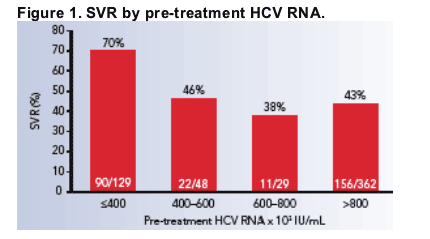
The logit of probability of SVR decreased to zero (no contribution towards predicting SVR) at about 5.6-log10 IU/mL.
Without adjustment, the actual probability of SVR decreased to 0.5 (no contribution towards predicting SVR) at a pre-treatment HCV RNA level of about 5.6-log10 IU/mL (about 400 000 IU/mL), and remained flat thereafter (Figure 2).
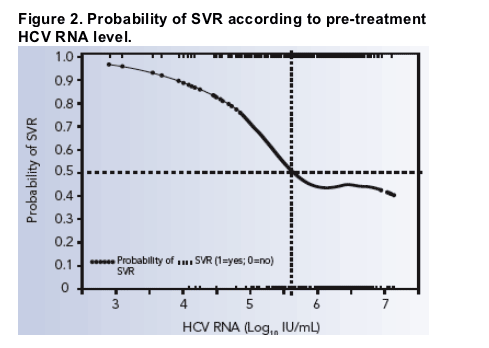
The choice of a 400 000 IU/mL cut-off was further confirmed using an ROC curve. The point on the curve that maximised the vertical distance from the 45-degree line (minimising total errors) corresponded to a viral load cut-off near 400 000 IU/mL (Figure 3).
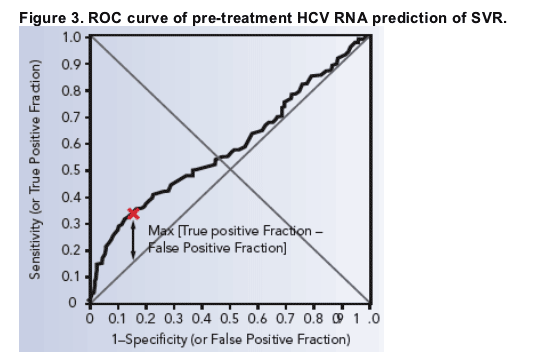
Having established a cut-off of >400 000 IU/mL as the appropriate definition for HVL, we then assessed differences in SVR rate between patients with pre-treatment HCV RNA levels above and below this threshold and the traditional threshold of >800 000 IU/mL for the two studies in the data mining phase (Figure 4) and all five studies from the validation phase (Figure 5).
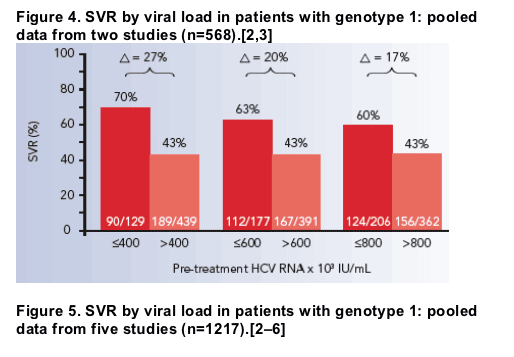
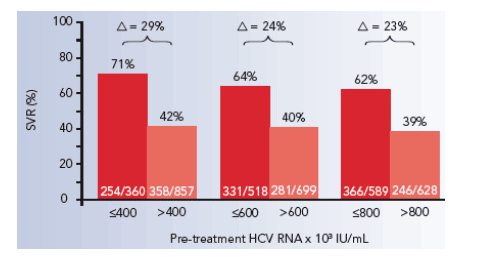
Consistent with the predictions of the GAM model, the cut-off of >400 000 IU/mL identified the greatest difference in SVR rates between patients with LVL and HVL (Figures 4 and 5).
REFERENCES
1. Strader DB, Wright T, Thomas DL, et al. Diagnosis, management, and treatment of hepatitis C. Hepatology 2004; 39: 1147-71
2. Fried MW, Shiffman ML, Reddy KR, et al. Peginterferon alfa-2a plus ribavirin for chronic hepatitis C virus infection. N Engl J Med 2002; 347: 975-82
3. Hadziyannis SJ, Sette H, Jr., Morgan TR, et al. Peginterferon-alpha2a and ribavirin combination therapy in chronic hepatitis C: a randomized study of treatment duration and ribavirin dose. Ann Intern Med 2004; 140: 346-55
4. Torriani F, Rodriguez-Torres M, Rockstroh JK, et al. Peginterferon alfa-2a plus ribavirin for chronic hepatitis C virus infection in HIV-infected patients. N Engl J Med 2004; 351: 438-50
5. Zeuzem S, Diago M, Gane E, et al. Peginterferon alfa-2a (40 kilodaltons) and ribavirin in patients with chronic hepatitis C and normal aminotransferase levels. Gastroenterol 2004; 127: 1724-32
6. Zehnter E, Mauss S, John C, et al. Efficacy of peginterferon alfa-2a (40KD) and ribavirin in patients with chronic hepatitis C in Germany- a contribution to health care research. Hepatology 2005; 42 (Suppl 1): S683A (Abstract 1233)
7. Hastie T, Tibshriani R. Generalized additive models. Chapman and Hall, London.
8. Berg T, von Wagner M, Hinrichsen H, et al. Definition of a pre-treatment viral load cut-off for an optimized prediction of treatment outcome in patients with genotype 1 infection receiving either 48 or 72 weeks of peginterferon alfa-2a plus ribavirin Hepatology 2006; 44 (Suppl 1): 321A (Abstract 250)
9. Zehnter E, Mauss S, John C, et al. Better prediction of SVR in patients with HCV genotype 1 (G1) with peginterferon alfa-2a (PEGASYS) plus ribavirin: improving differentiation between low (LVL) and high baseline viral load (HVL).
Hepatology 2006; 44 (Suppl 1): 328A (Abstract 368)
|
| |
|
 |
 |
|
|